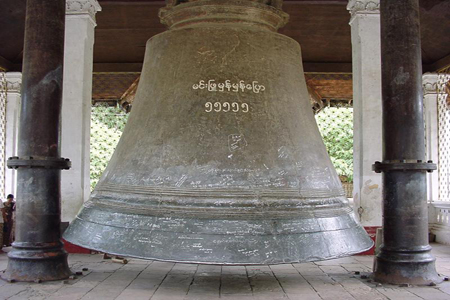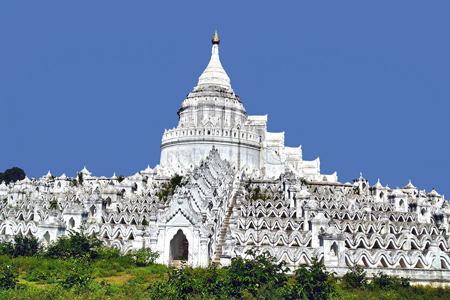At Mingun, a village on the right bank of Irrawaddy, and roughly about 7 miles north of Mandalay, which, you reach by a ferry boat or a sampan (country boat)in a Mandalay day tour, is the World’s Second Biggest Bell. Moscow has a bigger bell and as it has cracked since the Mingun Bell holds the pride of place as the world’s largest ringing bell. Cast in 1790 A.D., at the instance of King Bodawpaya, it was meant to go with the uncompleted Mingun Pagoda - a huge bell for a huge pagoda. The bell is 12 feet high on the outside, you can crouch under and then stand erect in the hollow of the bell inside! The diameter of the outer lip is 16 feet 3 inches and the weight of this giant is 90 tons. It fell off in the earthquake of 1938 and, now, it has been mounted afresh and covered over by a shelter open on all sides. Bells there are in their thousands in all the pagodas in Burma but here is one which leaves an indelible impression on your mind and makes you wonder at the emulative enthusiasm displayed by kings in glorifying the Buddha.

Just as you leave the boat and touch the bank, there is a small white pagoda, Pondaw Paya, a mere 15 feet high, designed as the working model for the Mingun Pagoda. If Bodawipaya (1781-1819), who planned its construction and spent 15 to 20 years over. It is said that he lived on the opposite bank, off and on, while the pagoda was under construction had not died when he did, the Mingun Pagoda would have been a magnificent one in central Burma in particular and all Burma in general, perhaps anywhere, rising to a height of 500 feet. As it stands, its bottom terrace (of a basement of five terraces) is a square of 450 feet. From the fifth terrace rises the pagoda, about 230 feet square and goes up to a height of 162 feet in all. Evidently, Bodawpaya had the square temples of Pagan in mind. As it is, it is a huge solid mass of bricks, shaken up by the earthquake of 1838. It is, as one writer has it “even in its ruined state, as large and imposing a mass of brick-work as is to be found anywhere. Since the pyramids of Egypt, nothing so great has been attempted and it belongs to the 19th century”.
Facing the river and in front of this pagoda are the shattered remains of the colossal brick lions.
A few hundred yards from the Bell, there is the Mya Thein Dan or Hsinbyume Pagoda, built by Bagyidaw in 1816, before he ascended the throne, to mark the death of his senior wife, Sinbyume. It is supposed to be an earthly duplication of the Sulamani Pagoda on the legendary Mount Meru in Tavatimsa, the Heavenly Abode of Indra. It is a circular construction, with seven concentric terraces, designed to represent the seven mountain ranges going up to Mount Meru. The earthquake of 1938 damaged this temple as well and its restoration was undertaken by King Mindon in 1874.

There is also the Settayvyã Pagoda, a hollow vaulted shrine, built by King Pagan (1846-1853). Here you find a foot-print of the Buddha in brick and stucco.
Here at Mingun and on the bank of the river, there is a unique social welfare institution, an Infirmary, founded by a Burmese lady, Daw U Zun, who gave her all for the purpose and now maintained by the Buddhist Infirmary Association and State grants. The Infirmary’s buildings are under huge shady trees, the unprotected aged among the Buddhists and non-Buddhists are equally welcome and there are, at present, sixty-five inmates. Food is carried in trays to those who are unable to walk the few yards across to the communal dining hall. There are small residential huts for the inmates.
Of special interest to the foreign tourist should be the Thanakha tree (murraya paniculata) found in the compound of this Infirmary. This tree yields an indigenous cosmetic of a delicate perfume - Burmese women paint their faces and even their bodies with the paste and powder made out of its bark and root.
